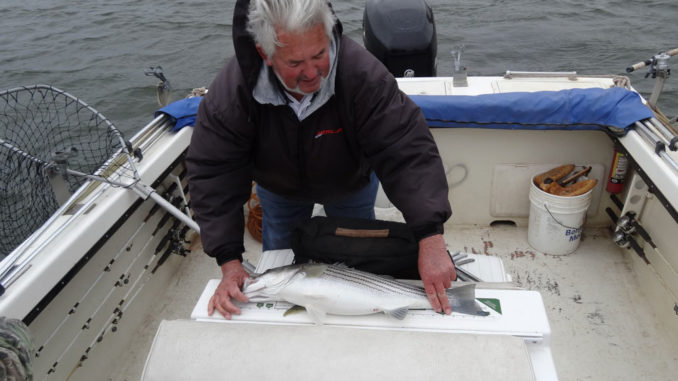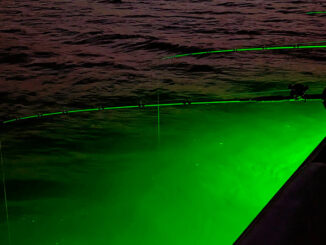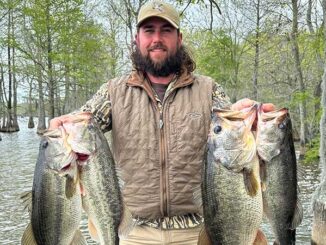
Anglers can keep fish, fishery can prosper
The new striped bass regulations approved by the South Carolina legislature and signed into law by Gov. Henry McMaster on May 3, 2018, became effective immediately, much to the delight of many Santee Cooper striper fishermen.
The new regulations stipulate that within the boundaries of the Santee River system, which includes Lake Marion and Lake Moultrie, from Oct. 1 through June 15, it is “unlawful to take or possess a striped bass less than 23 inches or greater than 25 inches, provided that one striped bass taken or possessed may be greater than 26 inches.”
For fishermen, the legal-speak is interpreted to mean that fish between 23 and 25 inches are legal, and one fish longer than 26 inches in length can be kept. That’s the same three-fish creel limit that’s been in effect for years, and all three fish kept by an angler can be in the 23- to 25-inch size class, but they have the option of keeping two fish within the slot-limit and one that is at least 26 inches or longer.
Although the 2018 season closed on June 16 through the end of September, the regulations were instituted early enough that anglers were able to utilize the new regulations for several weeks. According to numerous fishermen and landing owners, the feedback was extremely positive.
Scott Lamprecht, regional fisheries biologist for the S.C. Department of Natural Resources for the Santee Cooper system, said he’s heard from “very happy” fishermen.
Lamprecht said that the legislation passed was the result of some compromises, and that while not everything is ideal for the fishery and fishermen, it’s a very workable plan.
“I think we’re all very happy to see the bill passed, and I think it will enable the fishery to continue to thrive,” he said. “We’ve done extensive modeling on the striper fishery in Santee Cooper and feel confident that the slot limit of anglers keeping some 23- to 25-inch fish should not be a detriment to the long-term sustainability of the fishery. This enables angler to utilize fish for consumption as well as recreation.”
Lamprecht said SCDNR’s original proposal on keeping one large fish daily as part of the new limit was a 36-inch minimum length. The intent was to ensure plenty of larger fish with superior genetics surviving for potential spawning and natural recruitment.
“I would have liked to have seen the size set at around 28 to 30 inches to protect more big fish,” he said. “Our modeling that included harvest, mortality and other data showed the fishery would thrive with bigger fish protected and slot limit-size fish harvested. To really retain the best mixture of genes, we need to maintain a ‘file cabinet’ of multiple-age classes of spawners. These are the fish longer than 26 inches. But it was important to get this legislation approved, and compromise from various perspectives occurred.”
The launch of the new regulations created a couple of interesting issues anglers need to know. One is the one-inch “no-fry” zone of stripers between 25 and 26 inches.
Lamprecht said no fish in this size can be kept, they must be released immediately.
“This may be an enforcement challenge, but in one sense, this will preserve some of the fish in that size class to continue to grow to the larger, genetically superior stripers,” he said.
Lamprecht said a second consideration for anglers is the regulatory difference between the Santee and Cooper rivers. The initial legislation included the Cooper River, but in the final bill, the Cooper River portion was omitted.
This means the striper regulations for the Cooper River, below Pinopolis Dam, remains a creel limit of three, with a 26-inch size minimum.
“The Santee River is included in the legislation because it is in the Santee River basin, so the slot limit is in effect,” Lamprecht said. “In both the Santee and Cooper rivers, the fishing season now extends through June 15.”
The new legislation requires SCDNR to report impacts on the fishery to the legislature after three years.
“We make extensive annual reviews as part of our management program.” Lamprecht said. “We have a 30-year winter sampling program that we use to evaluate the fishery. At the end of the three years, we’ll have ample data to make a detailed report, with any new trends in the fishery hopefully emerging by then. The goal of the overall process is to sustain the fishery at a high level for both anglers and this valuable resource.
Lamprecht said anglers can help this cause by carefully releasing fish not meeting legal-size regulations. He said the new legislation allows for a fish longer than 26 inches to be kept but doesn’t require it.
“During the cooler months, these larger fish can still be caught and enjoyed, but released with an extremely high probability of surviving,” he said. “Three fish within the slot limit can be kept for consumption without harming the overall fishery. Releasing the larger fish is optional, of course, but has long-term benefits for the overall fishery.”
The keeper season for Santee Cooper stripers reopens on Oct. 1, with the new regulations.





Be the first to comment